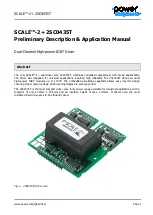
SCALE™-2+ 2SC0435T
Preliminary Description & Application Manual
www.power.com/igbt-driver
Page 10
The value of the dead time T
d
is determined by the value of the resistor R
m
according to the following formula
(typical value):
7
.
52
]
[
5
.
31
]
[
s
T
k
R
d
m
with 0.6μs<T
d
<4.1μs and 72kΩ<R
m
<181kΩ
Note that the dead time may vary from sample to sample. A tolerance of approximately ±20% may be
expected. If higher timing precisions are required, Power Integrations recommends using the direct mode and
generating the dead time externally (refer to the Application Note AN-1101 /4/).
INA, INB (channel drive inputs, e.g. PWM)
INA and INB are basically drive inputs, but their function depends on the MOD input (see above). They safely
recognize signals in the whole logic-level range between 3.3V and 15V. Both input terminals feature Schmitt-
trigger characteristics (refer to the driver data sheet /3/). An input transition is triggered at any edge of an
incoming signal at INA or INB.
SO1, SO2 (status outputs)
The outputs SOx have open-drain transistors. When no fault condition is detected, the outputs have high
impedance. An internal current source of 500μA pulls the SOx outputs to a voltage of about 4V when leaved
open. When a fault condition (primary side supply undervoltage, secondary side supply undervoltage, IGBT
short-circuit or overcurrent) is detected, the corresponding status output SOx goes to low (connected to GND).
The diodes D
1
and D
2
must be Schottky diodes and must only be used when using 3.3V logic. For 5V…15V
logic, they can be omitted.
The maximum SOx current in a fault condition must not exceed the value specified in the driver data sheet
/3/.
Both SOx outputs can be connected together to provide a common fault signal (e.g. for one phase). However,
it is recommended to evaluate the status signals individually to allow fast and precise fault diagnosis.
How the status information is processed
a) A fault on the secondary side (detection of short-circuit of IGBT module or supply undervoltage) is
transmitted to the corresponding SOx output immediately. The SOx output is automatically reset
(returning to a high impedance state) after a blocking time T
b
has elapsed (refer to “TB (input for
)” for timing information).
b)
A supply undervoltage on the primary side is indicated to both SOx outputs at the same time. Both SOx
outputs are automatically reset (returning to a high impedance state) when the undervoltage on the
primary side disappears.
TB (input for adjusting the blocking time T
b
)
The terminal TB allows the blocking time to be set by connecting a resistor R
b
to GND (Fig. 5). The following
equation calculates the value of R
b
connected between pins TB and GND in order to program the desired
blocking time T
b
(typical value):
51
]
[
0
.
1
]
[
ms
T
k
R
b
b
with 20ms<T
b
<130ms and 71kΩ<R
b
<181kΩ
The blocking time can also be set to a minimum of 9µs (typical) by selecting R
b
=0Ω. The terminal TB must not
be left floating.






































